- Home
- »
- Next Generation Technologies
- »
-
Hydroponics Market Size And Share, Industry Report, 2030GVR Report cover
![Hydroponics Market Size, Share & Trends Report]()
Hydroponics Market Size, Share & Trends Analysis Report By Type, By Crop Type (Tomatoes, Lettuce, Peppers, Cucumbers, Herbs, and Others), By Crop Area, By Region, And Segment Forecasts, 2024 - 2030
- Report ID: GVR-4-68038-162-7
- Number of Report Pages: 150
- Format: PDF, Horizon Databook
- Historical Range: 2017 - 2023
- Forecast Period: 2024 - 2030
- Industry: Technology
Hydroponics Market Size & Trends
The global hydroponics market size was valued at USD 5.00 billion in 2023 and is expected to grow at a compound annual growth rate (CAGR) of 12.4% from 2024 to 2030. The rapid growth in this sector is linked to the expanding utilization of hydroponic systems in the indoor cultivation of vegetables. Additionally, the increasing acceptance of alternative farming approaches for growing cannabis is experiencing a swift surge. This trend is propelled by the legalization of marijuana in various countries, including Canada, the Czech Republic, South Africa, and others. A growing awareness among consumers about the adverse effects of pesticides and artificial ripening agents on health is anticipated to fuel the demand for hydroponics. This is because hydroponic cultivation eliminates the necessity for such products, resulting in the production of nutritionally superior vegetables. Moreover, the low installation costs and operational simplicity of these systems are poised to further stimulate their adoption throughout the forecast period.
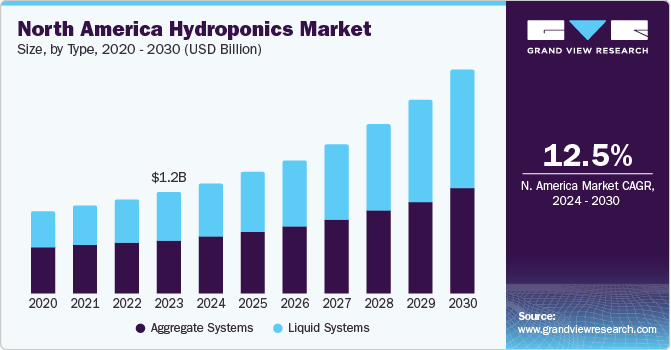
Hydroponic agriculture is a technique for cultivating plants without traditional soil, replacing it with a mineral solution strategically placed around the plant roots. In this method, plant roots are immersed in a chemical solution regularly monitored to uphold the correct chemical composition for optimal growth. Consequently, the hydroponic approach mitigates the risk of diseases caused by soil organisms. Furthermore, plants cultivated hydroponically yield greater outputs compared to their soil-grown counterparts due to precise control over nutrient levels.
The escalating global population is generating a heightened demand for food. As per the Food and Agriculture Organization (FAO) of the United Nations (UN), the world's population is projected to reach 9.1 billion by 2050, necessitating a corresponding increase in food production ranging from 25% to 70%. This surge is expected to propel the need for alternative farming technologies capable of delivering high yields within shorter timeframes. Particularly in regions like the Asia Pacific and Europe, where arable land and water resources are becoming increasingly scarce, there is a noticeable uptick in the adoption of alternative high-yield farming technologies, contributing to anticipated market growth.
Progress in climate control, nutrient farming techniques, sensing technologies, and related areas is anticipated to impact market expansion positively throughout the forecast period. Providers of hydroponics farming solutions present consumers with diverse tools for monitoring and overseeing their crops, including an array of sensors, web platforms, software, and mobile applications. One notable example is SmartBee Technology, Inc., which offers farmers real-time control through offerings such as irrigation controls, water and nutrient sensors, environmental sensors, and dedicated software.
The market is poised for growth due to several key factors, including a consistently increasing global population, limited availability of cultivable land, government incentives, and a rising demand for fresh, high-quality food. Notably, approximately 80% of the world's population resides in urban areas, as reported by the World Health Organization (WHO) and the Population Council. The scarcity of land in urban settings has spurred the adoption of innovative solutions like hydroponics. This method empowers growers to optimize various spaces for cultivating crops, whether it be indoors using layered systems, in multi-story buildings, on stacked racks, or within warehouses.
Hydroponic systems allow growing plants in nutrients and water without using soil as a base. Hydroponic systems are a combination of several technologies and include a specific set of system models. These systems enable growers to obtain higher yields with each harvest and eliminate the need for pesticides and herbicides as compared to traditional cultivation methods. Exotic vegetables, cabbage, peas, and salad vegetables grow well using hydroponics. Moreover, factors such as the easy availability of online education material and tutorials regarding the maintenance of these systems and huge discounts are creating vast demand for these systems among consumers. Crops such as tomatoes, exotic vegetables, cabbage, peas, and salad vegetables require proper care and continuous maintenance.
Market Concentration & Characteristics
The market growth stage in the hydroponics market is high, and the pace of the market growth is accelerating. The hydroponics market is marked by a robust culture of innovation, driven by the pursuit of cultivating superior-quality agricultural products in a cost-effective manner. The adoption of vertical farming and closely stacked plant configurations enables the simultaneous growth of diverse crop types, optimizing space and resources with minimal operational intricacies. This innovative approach not only enhances crop yields but also contributes to sustainability goals by maximizing output in a controlled environment. The industry's commitment to continuous improvement and resource efficiency positions hydroponics as a dynamic and forward-thinking segment within the broader agricultural landscape.
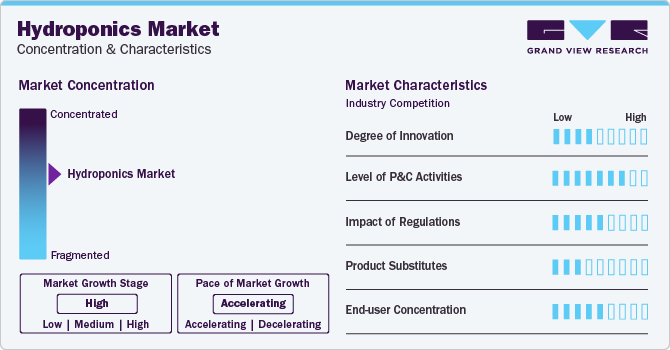
Farming as a service market is also characterized by a high level of merger and acquisition (M&A) activity by the leading players. This is due to several factors, including the desire to gain high market share and the need to consolidate in a rapidly growing market.
Farming as a service currently lacks a direct substitute, given its unique model of providing comprehensive agricultural solutions. Traditional soil-based farming remains a prevalent method, relying on natural soil for plant growth. Aquaponics, on the other hand, combines aquaculture (fish farming) with hydroponics, creating a symbiotic system where fish waste provides nutrients for plants. The choice between hydroponics and its alternatives often depends on factors such as space, resource availability, and the specific needs of the crops being cultivated.
Crop Area concentration plays a pivotal role in the hydroponics market. Hydroponics is adopted across diverse end use, including commercial agriculture, research and development, and home gardening. In large-scale commercial agriculture, hydroponic systems are deployed to enhance crop yield and quality, providing a concentrated application in this sector. Additionally, research and development institutions leverage hydroponics for controlled experiments and studies on plant growth, creating another concentrated end-use segment.
Type Insights
Based on type, the market is segmented into aggregate systems and liquid systems. The aggregate systems segment accounted for the largest revenue share of 52.5% in 2023, This preference is attributed to the user-friendly nature of aggregate systems, where inert and solid media like peat, rock wool, vermiculite, sand, sawdust, perlite, or coconut coir support plant growth. The utilization of key technologies such as drip systems, ebb and flow systems, and wick systems further underscores the segment's prominence.
The liquid systems segment is anticipated to record the most rapid compound annual growth rate (CAGR) of 14.2% in the forecast period from 2024-2030. This is attributed to the growing preference for closed-system cultivation among cultivators. Deepwater culture and Nutrient Film Technique (NFT) systems are increasingly being employed for cultivating leafy vegetables like lettuce. Liquid systems, devoid of a solid medium, submerge plant roots directly in the nutrient solution, simplifying the cultivation process. Additionally, by delivering nutrients directly to the plant roots, liquid systems accelerate growth, resulting in maximum yields. Despite soilless farming methods reducing the risk of soil-borne diseases, the recirculation of nutrient solutions in closed systems increases the potential dispersal of pathogens.
Crop Type Insights
Based on crops type, the market is segmented into tomatoes, lettuce, peppers, cucumbers, herbs, and others. The tomatoes segment accounted for the largest revenue share of 44.2% in 2023. Tomatoes hold the position as the most extensively cultivated hydroponic crop worldwide, primarily due to their rapid cultivation rate and significantly lower water requirements compared to conventionally farmed tomatoes. Indoor farmers typically employ growing materials such as rock wool, perlite, or coconut coir for hydroponic tomato cultivation. Projections indicate that by 2030, the hydroponic method is expected to witness substantial tomato cultivation in the Europe and Asia Pacific regions.
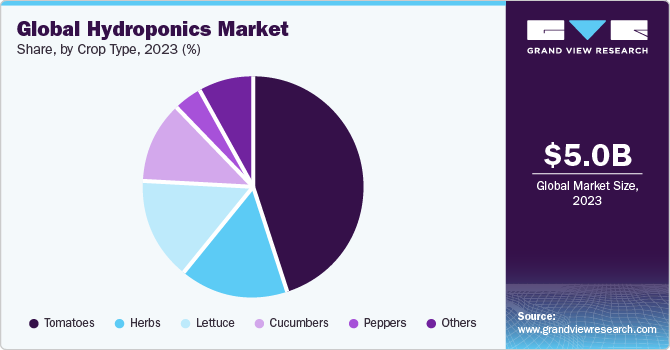
The lettuce segment is estimated to register the fastest CAGR of 15.4% over the forecast period from 2024-2030. Green and red leaf lettuce is the largest hydroponically grown vegetable among indoor farmers owing to its raw consumption in relatively large quantities. The hydroponic cultivation of lettuce is rising in North America due to its rising demand from households and fast-food chains across the region.
Crop Area Insights
The above 50,000 sq. ft. crop area segment is anticipated to contribute significantly to the global market's revenue. Larger crop areas offer farmers greater flexibility for cultivating multiple high-quality products. Moreover, the ability to install multiple hydroponic systems under one roof enhances productivity, while the deployment of advanced machinery and equipment increases operational efficiency and overall profitability. Additionally, the adoption of hydroponic systems in large farms contributes to water conservation, as these systems minimize water wastage compared to traditional soil-based farming practices. This scalability and efficiency make hydroponics an attractive choice for enhancing agricultural practices in sizable farming operations.
Regional Insights
Asia Pacific dominated the hydroponics market and accounted for the largest revenue share of 35.6% in 2023, owing to the substantial adoption of hydroponics in China, Australia, South Korea, and other such countries. The market in China and India is expected to escalate significantly over the forecast period due to emerging urban hydroponic farms.
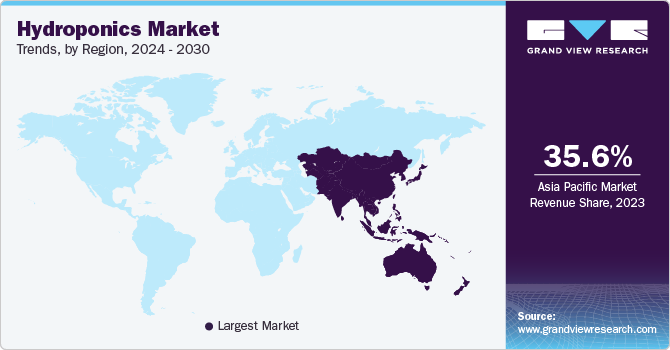
North America holds a high potential for growth on account of numerous companies located in the region and the growing adoption of alternative farming techniques in urban areas. Some of the prominent market players in North America include AeroFarms (U.S.), AMHYDRO (U.S.), Argus Control Systems Limited (Canada), and LumiGrow (U.S.). Europe is expected to register the fastest CAGR of 13.6% over the forecast period from 2024-200, as hydroponic systems offer an innovative solution by enabling efficient and controlled cultivation in indoor environments, mitigating the limitations associated with traditional farming. The presence of developed economies, including France, Germany, Italy, Spain, and the Netherlands, contributes to the robust growth of hydroponics, as these nations possess the necessary infrastructure and resources to invest in advanced agricultural technologies. Additionally, the expanding embrace of genetically modified crop technology further augments the appeal of hydroponics, providing a conducive environment for controlled cultivation practices and contributing to the anticipated accelerated growth of the market in Europe.
Canada Hydroponics Market
The hydroponics market in Canada is expected to account for a significant revenue share in the North America hydroponics market. Government initiatives and support programs aimed at promoting agricultural innovation and entrepreneurship further contribute to the expansion of the hydroponics industry in Cannada.
U.K. Hydroponics Market
The hydroponics market in the U.K. is expected to account for a significant revenue share in the Europe hydroponics market. Hydroponics in the UK has gained significant traction in recent years, driven by the increasing demand for sustainable agriculture practices and the desire for locally grown produce.
Germany Hydroponics Market
The hydroponics market in Germany is expected to account for a significant revenue share in the Europe hydroponics market. Hydroponics in Germany has experienced steady growth in recent years, propelled by several factors including increasing consumer demand for locally grown, sustainable produce and advancements in agricultural technology.
France Hydroponics Market
The hydroponics market in France is expected to account for a significant revenue share in the Europe hydroponics market. The France hydroponics industry encompasses a diverse range of applications, from large-scale commercial hydroponic farms to smaller urban and vertical farming operations. This method of soilless cultivation offers numerous advantages including higher crop yields, efficient water usage, and the ability to grow crops in urban environments with limited space.
China Hydroponics Market
The hydroponics market in China is expected to account for a significant revenue share in the Asia Pacific hydroponics market. Hydroponics in China has witnessed significant growth and adoption in recent years, driven by factors such as increasing urbanization, rising demand for high-quality produce, and the need for sustainable agricultural practices.
India Hydroponics Market
The hydroponics market in India is expected to account for a significant revenue share in the Asia Pacific hydroponics market. As India continues to modernize its agriculture sector and address challenges such as food security and environmental sustainability, hydroponics is expected to play an increasingly important role in the country's food production landscape.
Malaysia Hydroponics Market
The hydroponics market in Malaysia is expected to account for a significant revenue share in the Asia Pacific hydroponics market. Government support and investment in agricultural technology and innovation further contribute to the growth of the hydroponics industry in Malaysia.
Japan Hydroponics Market
The hydroponics market in Japan is expected to account for a significant revenue share in the Asia Pacific hydroponics market. Japan continues to prioritize sustainability and innovation in agriculture, the hydroponics sector is expected to further expand, supported by government initiatives promoting urban farming and research and development in agricultural technology.
South Africa Hydroponics Market
The hydroponics market in South Africa is expected to account for a significant revenue share in the Middle East & Africa hydroponics market. Hydroponics offers several advantages in the South African context, including higher crop yields, efficient water usage, and year-round production regardless of seasonal variations.
Middle East & Africa Hydroponics Market
The hydroponics market in the Middle East & Africa is expected to witness noticeable growth in the coming years. Small-scale farmers and entrepreneurs are increasingly turning to hydroponic farming as a viable alternative to traditional agriculture, offering opportunities for food security, income generation, and job creation.
Key Hydroponics Market Company Insights
The market participants are focusing on several strategies to gain a higher market share. Mergers, acquisitions, partnerships, and other contractual agreements are being announced by them to emerge as the top hydroponics company.
Some prominent players in the market include AeroFarms, AmHydro, Argus Control Systems Limited, BrightFarms., Heliospectra and UrbanKisaan, among others.
-
AeroFarms is a company that is engaged in providing sustainable indoor agriculture solutions. AeroFarms' hydroponic systems use a patented cloth medium as a substitute for soil, providing optimal support for plant roots while enabling precise nutrient delivery. The company leverages advanced technologies, including data analytics and machine learning, to monitor and control the growing conditions. This ensures that plants receive the exact nutrients they need, resulting in efficient resource use and high-quality crop yields.
-
AmHydro is a company specializing in hydroponic systems for agricultural cultivation. The company offers complete hydroponic growing systems, including nutrient delivery systems, growing channels, and other essential components. AmHydro's systems are designed to optimize plant growth by providing precise control over environmental factors such as nutrient levels, pH, and oxygenation. This allows for efficient resource use and can result in higher yields compared to traditional soil-based farming.
-
Freight Farms and Urban Crop Solutions are some of the emerging market participants in the target market.
-
Freight Farms is a hydroponic solution provider. The company, through its innovative Leafy Green Machine, offers customers hydroponics solutions. The Leafy Green Machine is a shipping container converted into a hydroponic farm, allowing for year-round cultivation.
-
Urban Crop Solutions company offers end-to-end hydroponic Indoor vertical farming solutions. The company offers solutions for indoor farming, including hydroponics and vertical farming systems, with a focus on smart and automated technologies.
Key Hydroponics Companies:
The following are the leading companies in the hydroponics market. These companies collectively hold the largest market share and dictate industry trends. Financials, strategy maps & products of these hydroponics companies are analyzed to map the supply network.
- AeroFarms
- AmHydro
- Argus Control Systems Limited
- Emirates Hydroponics Farms
- Freight Farms, Inc.
- BrightFarms.
- Heliospectra
- Signify Holding
- Nutrifresh India
- UrbanKisaan
Recent Developments
-
In January 2022, Hydrobuilder Holdings LLC, a global omni-channel retailer of specialty agriculture and hydroponics equipment and supplies announced the acquisition of New England Hydroponics. The acquisition is expected to help the company strengthen its position in the global market.
-
In December 2020, GrowGeneration Corp., a global provider of specialty hydroponic solutions announced the acquisition of Grassroots Hydroponics, a three-store chain of hydroponic garden centers. The acquisition is expected to help the company increase its presence in Southern California and strengthen its position in the U.S. market.
-
In May 2023, AeroFarms established a strategic partnership with Amazon Fresh, extending its reach to both online platforms and all physical Amazon retail stores. This collaboration is expected to significantly promote AeroFarms' product, leveraging the extensive customer base and distribution network of Amazon Fresh.
Hydroponics Market Report Scope
Report Attribute
Details
Market size value in 2023
USD 5.00 billion
Revenue forecast in 2030
USD 10.98 billion
Growth Rate
CAGR of 12.4% from 2024 to 2030
Actual data
2017 - 2023
Forecast period
2024 - 2030
Quantitative units
Revenue in USD billion and CAGR from 2024 to 2030
Report coverage
Revenue forecast, company ranking, competitive landscape, growth factors, and trends
Segments covered
Type, Crop Type, Crop Area, and Region
Regional scope
North America, Europe, Asia Pacific, South America, MEA
Country scope
U.S.; Canada; Mexico; U.K.; Germany; France; Japan; China; India; Brazil
Key companies profiled
AeroFarms; AmHydro; Argus Control Systems Limited; Emirates Hydroponics Farms; Freight Farms, Inc.; BrightFarms.; Heliospectra; Signify Holding; Nutrifresh India; UrbanKisaan
Customization scope
Free report customization (equivalent up to 8 analysts working days) with purchase. Addition or alteration to country, regional & segment scope.
Pricing and purchase options
Avail customized purchase options to meet your exact research needs. Explore purchase options
Global Hydroponics Market Report Segmentation
This report forecasts revenue growth at global, regional, and country levels and provides an analysis of the latest industry trends in each of the sub-segments from 2017 to 2030. For this study, Grand View Research has segmented global hydroponics market report based on type, crop type, crop area, and region.
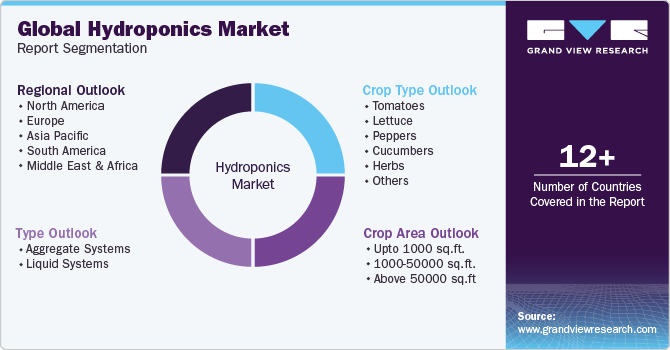
-
Type Outlook (Revenue, USD Billion, 2017 - 2030)
-
Aggregate Systems
-
EBB & Flow Systems
-
Drip Systems
-
Wick Systems
-
-
Liquid Systems
-
Deep Water Culture
-
Nutrient Film Technique (NFT)
-
Aeroponics
-
-
-
Crop Type Outlook (Revenue, USD Billion, 2017 - 2030)
-
Tomatoes
-
Lettuce
-
Peppers
-
Cucumbers
-
Herbs
-
Others
-
-
Crop Area Outlook (Revenue, USD Billion, 2017 - 2030)
-
Upto 1000 sq.ft.
-
1000-50000 sq.ft.
-
Above 50000 sq.ft
-
-
Regional Outlook (Revenue, USD Billion, 2017 - 2030)
-
North America
-
U.S.
-
Canada
-
Mexico
-
-
Europe
-
Germany
-
U.K.
-
France
-
-
Asia Pacific
-
China
-
Japan
-
India
-
-
South America
-
Brazil
-
-
Middle East and Africa (MEA)
-
Frequently Asked Questions About This Report
b. The global hydroponics market size was estimated at USD 4.65 billion in 2022 and is expected to reach USD 5.00 billion in 2023.
b. The global hydroponics market is expected to grow at a compound annual growth rate of 11.9% from 2023 to 2030 to reach USD 10.98 billion by 2030.
b. The Asia Pacific dominated the hydroponics market with a share of 35.8% in 2022. This is attributable to the substantial adoption of hydroponics in China, Australia, and South Korea.
b. Some key players operating in the hydroponics market include AeroFarms, AmHydro, Argus Control Systems Limited, Emirates Hydroponics Farms, Freight Farms, Inc., BrightFarms., Heliospectra, Signify Holding, Nutrifresh India, and UrbanKisaan
b. Key factors that are driving the hydroponics market growth include increasing investments made and incentives provided by the governments worldwide to encourage alternate farming technologies and higher yields from hydroponic farms.
Share this report with your colleague or friend.
![gvr icn]()
NEED A CUSTOM REPORT?
We can customize every report - free of charge - including purchasing stand-alone sections or country-level reports, as well as offer affordable discounts for start-ups & universities. Contact us now
![Certified Icon]()
We are GDPR and CCPA compliant! Your transaction & personal information is safe and secure. For more details, please read our privacy policy.
We are committed towards customer satisfaction, and quality service.
"The quality of research they have done for us has been excellent."





